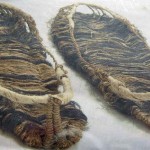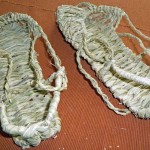About ten years ago, Korean archaeologists exhumed the partially mummified remains of Eung-tae, a male member of an ancient clan. The tomb was dated to the mid to late 1500s. It contained articles of clothing and writings, including letters and poems. Hyung-eun Kim wrote a very interesting article about this family of mummies entitled “Korean Love Affair” for Archaeology magazine. Of particular interest to the Straw Sandals Project was the discovery of a pair of sandals made of human hair in Eung-tae’s tomb. They were wrapped in a paper package and placed by his head. It is thought that his widow may have made them using her own hair. Readers of the article will be rewarded with many details and images of this find. It is stated in the article that Korean literature contains references to the practice of using human hair to craft shoes to symbolize love or hope for recovery from sickness. These sandals, shown below on the left, are the first known examples. The second image, shown below on the right, is from the Straw Sandals Collection. I photographed item K1 from the same perspective as the image of the Korean hair sandals. K1 are contemporary straw sandals that I purchased from a seller in South Korea. They are the same style of sandal as the ancient hair sandals from Eung-tae’s tomb. This then is an example of an old weaving design that has persisted into the present. (Click on images to enlarge)

